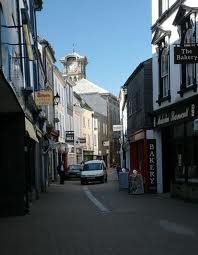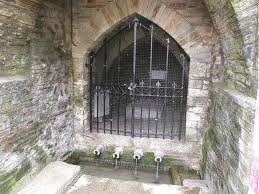


Ancient market & Stannary town
Web: www.visitliskeard.co.uk
Web: www.visitcornwall.com/destinations/liskeard
Liskeard is an attractive market town conveniently situated on the main railway line between London and Penzance about twenty miles west of Plymouth and served by the A38 and A390 roads. It is the geographical centre of south east Cornwall and the shops, services and amenities are used by tourists and residents from many attractive villages in the area. A branch railway line and scenic road give easy access to Looe, Polperro and the beautiful south coast while just four miles to the north begins the high open country of Bodmin Moor. The population of the town was 9,301 at the 2011 census.
Liskeard has been a settlement since the Norman era, in 1240 Richard, Earl of Cornwall granted the town a Royal Market Charter, since then it has been a location for agricultural progression. Liskeard still holds a livestock market every Tuesday, the Liskeard Lions have held a carnival every autumn since 1976 and the Liskeard show is held every second Saturday in July and the St. Matthews Fair has been held since 1266.
A Norman castle was built there after the Conquest, which eventually fell into disuse in the later Middle Ages. By 1538 when visited by John Leland only a few insignificant remains were to be seen.
The town offers a wide variety of shops and services for visitors and residents alike with most being located in the Bay Tree Hill, Pike Street and Fore Street area. Liskeard was one of the last towns in Cornwall to have a regular livestock market, ending in 2017.
Liskeard is an ideal base from which to explore. Situated at the head of the Looe Valley, it has long been an important market centre, and was one of the four original Stannary towns. The mining industry played an important part in the town's growth, and in 1828 a canal link enabled ore and stone to be carried down to Looe. The railway which replaced it has become today's single track branch line along scenic wooded riverbanks, the Looe Valley Line.
A Norman castle was built here after the Conquest, which eventually fell into disuse in the later Middle Ages. By 1538 when visited by John Leland only a few insignificant remains were to be seen.
Liskeard remains a picturesque and lively market town, full of interesting buildings: a Victorian Guildhall and clock tower built in 1859; the Stuart House where Charles I stayed in 1644; and the second largest church in Cornwall (St. Martins). Webb's Hotel built in 1833 is a classic early Victorian market-town hotel featuring in royal visits, parliamentary declarations and much more but recently converted into flats and was the home of the local newspaper The Cornish Times which was started there in 1857. The Public Hall was built in 1890 and provides a venue for a range of community activities as well as being home to the Town Council Offices. More recently the Foresters Hall (built in 1896) was acquired to house the Town Museum and Information Centre. The Liskeard Union workhouse was built in 1838 on a two and a half acre site at the west side of Station Road. It was intended to accommodate 350 inmates. The building later became the Lamellion Hospital, but now has been converted into private flats.
The first school in Liskeard was founded in 1550 on Castle Hill. For a time it was maintained by the Earls of St. Germans, but it closed around 1834 due to a decline in numbers and financial difficulties. From 1835 a series of private schools existed in the borough, until 1908 when Cornwall Education Committee built the County School at Old Road. From 1945 it was known as Liskeard Grammar School until September 1978 when it became the Lower School site of Liskeard School, following amalgamation with the town's secondary modern school. Liskeard County Secondary School at Luxstowe opened on Monday 12th September 1960 and has gradually been expanded over the years.
Liskeard puts on a pantomime in the last week of January with two nights free entry for the OAPs and holds a very popular carnival every June all arranged by the Liskeard Lions.
On the 21st July 1973 Liskeard Swimming Pool was opened by HRH Princess Margaret.
In June 1976 Liskeard bypass opened thus relieving the town centre of most of the heavy traffic travelling through the town along the A38.
West of Liskeard, just off the A38, Dobwalls Family Adventure Park offers a range of attractions. Nearby, on the road to St. Neot, are the interesting Carnglaze Slate Caverns. At St. Cleer, on the edge of the moors and surrounded by farmland, another Holy Well can be found. Housed in a granite baptistry, the well was used to treat the insane, who were repeatedly tossed up and down in the water until sanity returned. North of St. Cleer stands King Doniert's Stone, on which a Latin inscription asks for prayers for the Cornish King, who drowned in 878. Nearby is the Neolithic burial chamber known as Trethevy Quoit dating from 3500BC, where five huge stones support a massive capstone. Also nearby is the beautiful Siblyback Lake Country Park.
To the north west of Liskeard lies the windswept uplands of Bodmin Moor, a designated Area of Outstanding Natural Beauty, and dominated on its southern edge by Caradon Hill. The moors, shrouded in mist and mystery, hold abundant clues for those who want to delve into the past - burial chambers and holy wells, giant stones and Bronze Age settlements, decayed mine-workings and disused quarries. When you visit the moors you are retreading the footsteps of Neolithic man, of Cornish Kings, and of the thousands of miners who once worked the area.

The town now has an excellent leisure centre at Lux Park, PL14 3HZ.
Liskeard Community Hospital opened in 2004.
Liskeard was one of the last towns in Cornwall to have a regular livestock market, ending in 2017.
The town's Tourist Information Centre is at Foresters Hall, Pike Street, PL14 3JE.
The mural depicts the history of Liskeard and South East Cornwall from earliest times. This part of it depicts the industrial revolution and the coming of the railway, two things that had a huge influence on Liskeard. It can be found in Pig Meadow Lane between the town’s main car-park and the Parade.
Pipe Well can be found in Pipe Well Lane, at the rear of Fore Street, and is often referred to in old documents as 'The Well', 'The Well of Lyskiret', or the 'Well of St. Martins'. The well is fed by four springs and has never been known to run dry. The water was believed to possess miraculous healing powers especially in relation to those with poor eyesight.
Liskeard Heritage Trail is a self guided walk around the town which provides information about all the interesting buildings in the town and takes around 1.5 hours to complete.
The Henry Rice Trail identifies over one hundred buildings in Liskeard which were designed by Henry Rice in the 19th century as a result of the wealth created by the boom in copper mining.
The Caradon Trail links the town with Bodmin Moor. Enjoy the traditional Cornish lanes and hedgerows, the abundance of wildlife and the sweeping views across moorland and river valleys, while retracing the rich heritage of the area from Neolithic megaliths to 19th century industrial mining landscapes.
The guides are available free of charge from Stuart House and Liskeard Information Centre.
Liskeard Carnival Week - late June.
Liskeard Agricultural Show - July.
Dobwalls Beer Festival - mid July.
The Great Trethew Vintage Rally - end of August
Liskeard Lights Up - early December.
Emily Hobhouse (1860-1926) Formed a relief fund for Boer women in South Africa born was born at St. Ive near Liskeard.
Richard Coad (1825–1900), born in Liskeard was a 19th-century Cornish architect who was involved in the re-building of Lanhydrock House.
Joseph Jane (1595–1658) was an English royalist politician.
Tristan Sturrock (1968-) Actor born at Upton Cross near Liskeard.
Bodmin Bodmin Moor Callington Liskeard Museum Moyclare Garden Siblyback Lake Country Park
Liskeard Castle Menheniot Minions Looe Lostwithiel Saltash St. Cleer St. Neot Pelynt
Carnglaze Slate Caverns Dobwalls Family Adventure Park Magnificent Music Machines Adrenlin Quarry
Cornish Orchards Kartworld Ken-Caro Gardens Looe Valley Vineyard
Sterts Theatre & Arts Centre The Caradon Trail Stuart House